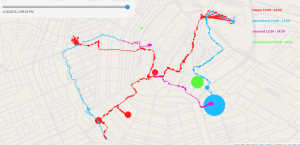Mapping Invisibility
Performative mapping can be a powerful way to engage with ‘the other’. The workshop MAPPING INVISIBILITY ‘visualised’ undocumented citizens’ experience of and hiding strategies in the public spaces of Amsterdam. As part of the thematic program Out of State*, Naomi Bueno de Mesquita (TRADERS researcher at Design Academy Eindhoven) presented MAPPING INVISIBILITY on January 20th 2015. It aimed to open the debate about the current policy regarding the presence of people without the right papers, and that of a steadily growing shadow society (the scenography of sheltering and looking away).
In the workshop (which took place a week prior to the presentation) a number of illegal immigrants (experts in living invisibly in the city) guided participants to places in the city with an emotion in mind (a total of four emotions were mapped). Prior to the fieldwork a legend was generated by the participants, consisting of emotions that they thought undocumented citizens experience in the city. While walking/ mapping the participant could evaluate preconceived ideas (to what extent the chosen words matched reality or not) in the dialogue with the undocumented. Changing from one emotion to another happened at a fixed time and for all cartographers simultaneously, until all the words of the legend were mapped. The guests rediscovered the diverse meaning and associations of public places and were introduces to strategies of hiding, such as avoiding to walk with a bag, pretending to be waiting for a train, etc.
A web applications traced the cartographers footsteps while recording the dialogue. The longer they stayed on a certain location the thicker the line on the digital map would become, this way communicating the importance of a place in relation to an emotion and visualising the diverse way of responding to a similar emotion (one might prefer to be stationed somewhere when it comes to a certain emotion, while another might prefer to walk). The conversation can be followed by downloading the audiotrack on this website: http://performativemapping.net/outofstate. The tracks can only be heard by being present on the exact same location and by walking the same track.
The map of emotional journeys are the result of the walked emotions. As long as the host and guest walked, a line was shown. The longer they stayed on a certain location the thicker the line became, until it turned into a dot. This way of drawing with time is a way to visualise the different responses of the stateless to a similar emotion (one might prefer to be stationed somewhere when it comes to a certain emotion, while another might prefer to walk).
The photo archive shows places, traces, materials, objects and behaviours that have to do with hiding/ sheltering from reality. The pictures were taken while walking.
The audio map consists of different tracks of stories related to ‘living invisibly’. During the mapping practice the conversation with the undocumented was recorded. The story is an mp3 that ‘visitors’ can listen to with a mobile phone and headphones by being on the same location and downloading the track. Only through being physically present on the location or following the same walked route, the story is revealed. If the visitor deviates from the place or the route (range of 20 m) the audio fades out. This way of aligning with the undocumented to reveal the story behind places or objects in the city, plays with a tension between hiding and making public which is a daily recurrent theme for the undocumented.
The elements of TIME in this workshop – the taking of time and synchronising (either face to face or by retracing someone’s steps) – were the prerequisites to create a space of engagement.



